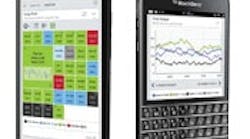Mohawk Paper in Cohoes, N.Y., has a history of adapting to new ideas and technologies. Mohawk was the first U.S. paper mill to match 100% of its electricity with renewable wind power and the first U.S. premium paper mill to shift toward carbon-neutral production. So BYOD is not an unexpected step for them.
Paul Stamas, vice president of information technology at Mohawk, says, "Mohawk hasn't adopted a corporate BYOD solution for general mobile computing, but we've implemented a targeted BYOD solution to monitor and control company processes and operations remotely. Our view of BYOD seeks to ensure that a specific enterprise footprint is provided on a personally owned or a company-provided device, with either limited to certain applications and data. In our case, that's manufacturing applications and data."
Mohawk implemented a BYOD solution from Transpara called Visual KPI. Visual KPI delivers enterprise information to users anywhere on any web-enabled mobile device to monitor KPIs such as production performance and energy consumption in real time. "The Visual KPI system was implemented four years ago and has been expanded to provide anytime, anywhere access to a range of business and production metrics," Stamas says. "Using smartphones and tablets, our employees can monitor equipment and processes while working in another part of the factory or anywhere outside the facility."
One technical challenge Mohawk needed to overcome was accessing data from the enterprise system with Visual KPI. "We used the PI historian from OSIsoft, which has very tight integration with Visual KPI for real-time display and trending, to obtain non-process manufacturing data from our ERP system," he explains. "We developed a SQL query to extract data such as customer orders, production status and inventory levels from our ERP system. We then write this extracted data to an historian tag that's correlated with process data collected, with the results seamlessly displayed on the mobile devices."
By monitoring information from a wide array of processes, such as order entry, scheduling, inventory, production and industrial process control systems, Mohawk ensures the entire enterprise is constantly aligned and focused on key orders, priority requirements, last-minute changes and what's happening on the production floor.
"This lets us respond rapidly to customers' ever-changing requirements and market changes," Stamas says. "The implementation of Visual KPI improved the quality and timeliness of our decision-making in manufacturing and maintenance processes and enhanced our responsiveness to customer requirements and manufacturing issues due to real-time access to machine, production and order status."
Visual KPI information can be viewed via any standard web browser such as IE, Chrome, Firefox or Safari on a PC or on a smartphone or tablet. Information also can be viewed using a Visual KPI app on an iPhone or Android mobile device.
Secure real-time access to data in the ERP—and the manufacturing systems—is through the corporate firewall. Remote access to sensitive information is secured through authentication, firewall rules and data encryption.
"Honestly, this has been seamless and very easy to use," Stamas concludes. "I can't think of any real challenges we've had with the mobile application. I should state the obvious that extending enterprise information to a mobile device is straightforward, assuming your data and information are easily accessible from your enterprise systems. For Mohawk, we have knowledge and capabilities to access and manipulate data directly from our manufacturing systems, which made exposing them via mobile applications straightforward."
This article was published in our 2014 Q2 issue of Industrial Networking along with our cover story "BYOD Gains Traction as Employees Demand Access from Mobile Devices."





